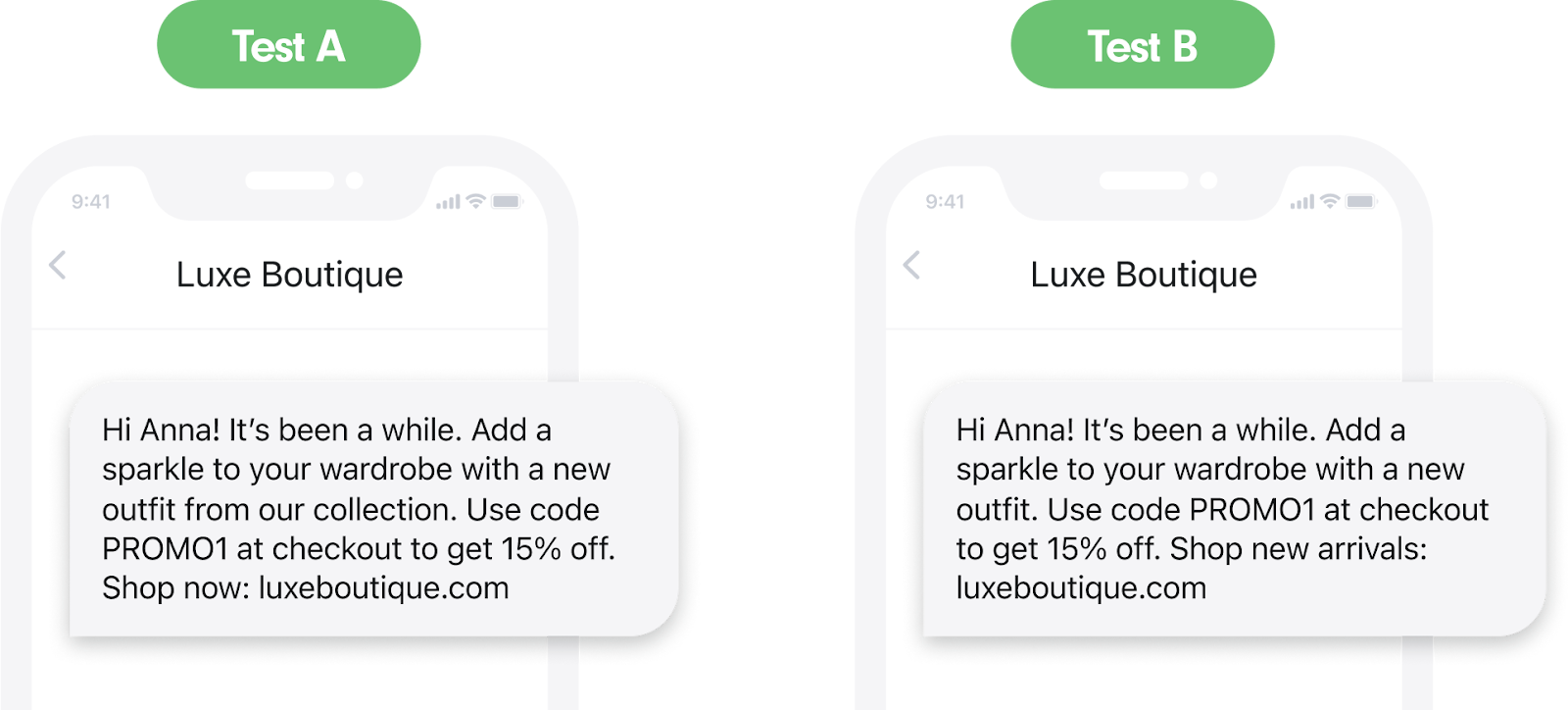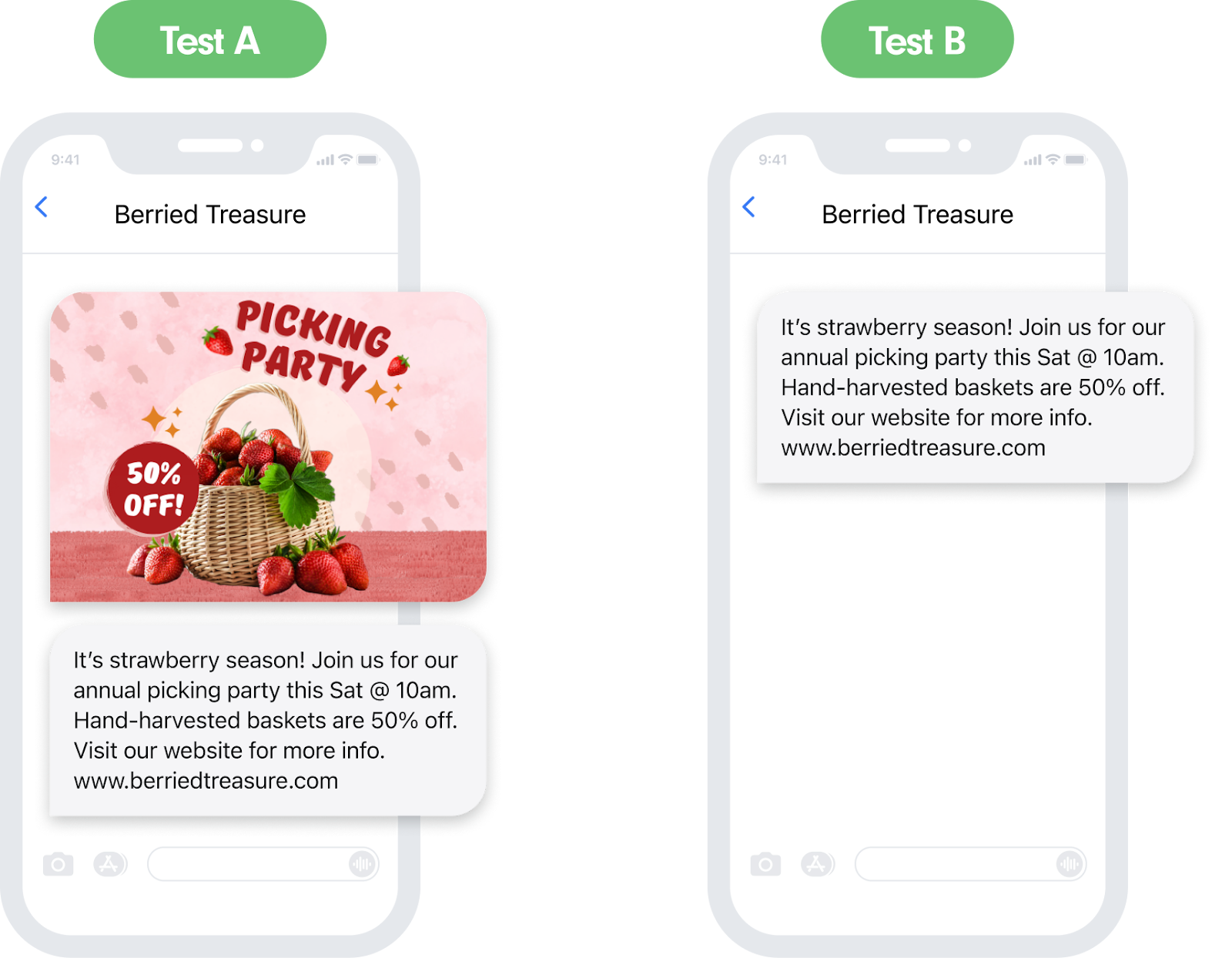If you need a strategy to help you optimize your SMS campaigns, look no further than A/B testing. By running these controlled experiments, you’ll gain data-driven insights to improve results and ensure your marketing messages resonate.
Let’s dive into everything you need to know to start SMS A/B testing, including what to test, how to design the test, and how to analyze results.
Jump right to:
- What is SMS A/B testing?
- 20 SMS A/B test campaign ideas
- Tips for designing the test
- Best practices for executing the test
- How to analyze the results
<h2 id="What">What is SMS A/B testing?</h2>
SMS A/B testing is a controlled experiment that compares variations of a text marketing campaign to determine how different factors affect its performance. Often called split testing, A/B testing helps identify the version that performs best based on metrics like clicks, sign-ups, or revenue generated. These tests aim to eliminate the guesswork for campaign optimization.
Overall, A/B testing gives marketers, product developers, and designers the data they need to improve results. It’s an effective strategy that can boost revenue, engagement, user experience, customer satisfaction, and more.
<h2 id="Ideas">20 SMS A/B test campaign ideas</h2>
Now that you know the definition of A/B testing, what factors can you test for SMS marketing? Let’s dive into 20 A/B testing ideas for texting.
Message content
One of the best ways to use A/B testing is to see how different messaging content and attributes impact results. When trying different content, here are some other tests to consider.
- Call-to-action. One of the most critical components of a marketing message is the CTA. Use an A/B test to understand if one specific CTA performs better. For example, you could test “Shop now” vs. “Shop new arrivals.”
- Personalization. See if adding personalization, like a customer's first name, drives better results than a generic message. For example, does “Hey Mariah” or “Hey!” drive better results?
- Length of message. Another message content attribute to check is text message length. You can see if a short, snappy, or more descriptive text worked better. Remember, a typical text is 160 characters.
- Message tone. You can also work to understand how the tone of your text message makes a difference. For example, you can test a more playful tone of voice against a more formal one.
- Spacing. You can also test whether the spacing between your message and CTA affects engagement.
- Copy changes. You can also test the actual wording of your message to see if one version appeals more to your audience than another.
- Emoji usage. See if adding an emoji to your text message improves results. Run an A/B test comparing a message with an emoji vs. one without an emoji.

Offers and incentives
Another good A/B testing campaign strategy focuses on understanding how your target audience reacts to discounts and incentives. Here are some ideas to test:
- Discount amounts. Test to see if different discount levels drive better results. For example, does 15 percent, 20 percent, or 25 percent off drive more revenue and conversions?
- Limited-time offers. You can also compare limited timeframes to understand if urgency affects campaign performance. For example, test whether a 24-hour or 48-hour sale drives better results.
- Exclusive deals. You can also see if including language about exclusive offers improves results. For example, a business could compare a message that offers an exclusive discount for SMS subscribers to one without exclusivity language.
Interactive variations
Another great A/B test idea is to see how different visuals and interactive elements affect performance. Here are some variations to compare.
- Image vs. text. See if including a visual along with your text, called MMS, drives better results. A standard text-only message may also be better in some scenarios.
- GIF vs. still image. Your business could test whether or not adding a moving visual element like a GIF improves engagement compared to a still photo.
- Interactive elements. See if other interactive elements, like an emoji puzzle or trivia, improve results compared to a standard text message.
- Link placement and destination. See if moving the link to the top, middle, or bottom of your copy influences conversions. You can also test whether directing customers to a different landing page improves results.

Message timing and frequency
The optimal time to send a text message will differ based on your SMS use case, industry, and customer preferences. Use an A/B test to help you determine which time works best for your unique business needs. Here are some split test ideas related to timing and frequency.
- Time of day. Use an A/B test to understand if the send time makes a difference. You can see if sending a mass text to your clients in the morning, afternoon, or evening improves results.
- Day of the week. Test to see if a campaign launched on a particular day of the week makes the biggest splash. For example, a text sent on a weekday may have a better open rate than one sent over the weekend.
- Time lapsed. Sometimes you might have text automations set up, like abandoned cart reminders. Test whether the amount of time lapsed makes a difference. For example, does sending a cart abandonment message 30 minutes or one hour post-abandonment make a difference?
- Frequency. You can also use split testing to understand if different message frequencies increase conversions. For example, compare the results from when you send four texts per month vs. five texts a month.
Sender information
You could also test sender information to see if it improves your SMS metrics.
- Sender name. See if including your sender name in the front, middle, or end of your copy helps to improve your SMS campaign. You can also test if adding your logo and brand name to the top of a text affects open rate.
- Short code vs. long code. Run a test to see if sending your text campaign from a local number like a 10DLC improves open rate compared to a short code number.

<h2 id="Design">Tips for designing the SMS A/B test</h2>
Here are some key steps and tips to keep in mind for designing an effective SMS A/B test.
- Pick one variable. While there may be many variables you’ll want to compare, the key to a proper A/B test is to choose just one at a time. You’ll want to choose an isolated variable so you can ensure that any statistically significant results are attributed to that variable.
- Pick your metric. Before running a test, choose which specific metric you want to track. For example, do you want to look at the open rate, click-through rate, conversions, or return on investment? While you can track all of these, you will want to choose a main one to draw conclusions about.
- Create two versions of the text. You’ll want to create version A and version B of your text message to compare. One will serve as the control message and the other will serve as a challenger.
- Set up proper test parameters. Before launching your test, ensure your sample size and test duration are set up. To ensure your results are accurate, create two random and equal subscriber segments. To compare results, send one group the control text and the other group the challenger text. You’ll also want to ensure you’re testing it on a large enough sample for a long enough duration.
<h2 id="Execute">Best practices for executing the A/B test</h2>
Keep these tips in mind for executing your SMS A/B test.
- Give your test enough time. To be statistically relevant, you’ll want to ensure you’re running your test long enough. There’s no right duration, but you’ll want to ensure enough people have time to act on your text message to produce accurate data.
- Be mindful of when you test the variations. If you’re testing different content, you’ll want to ensure that you’re testing version A and version B at the same time so that other factors like timing are not at play. If you’re testing the day of the week, send it in the morning on both versions, so you know that time of day isn’t at play. Be mindful that you’re only testing one variable at a time.
- Monitor in real-time. One of the best ways to ensure your test is running properly is to track progression in real-time. For example, you can see how many people clicked on a link to see if one version is outperforming the other.
<h2 id="Analyze">How to analyze test results and implement insights</h2>
Here are some tips and tricks to analyze SMS A/B test results so you can make the improvements you need.
- Focus on your key metric. Although you’ll keep tabs on multiple metrics, pay attention to your north star. For example, if you run a version A that has a higher click-through rate but fewer conversions, you may end up sending out version B.
- Determine statistical significance. You’ll also want to determine the statistical significance of your results. This means measuring how likely that the difference you’re seeing in results is due to the change applied rather than error or random chance. To help you determine this quickly, you can find a statistical significance calculator like SurveyMonkey’s online.
- Apply results. Once you determine your results are significant, you can apply the change to the copy, timing, etc., and send the campaign out to the rest of your contact list.
- Work to improve consistently. The best marketers are continuously testing and making decisions based on the data. After completing one A/B test, your business should already be considering what factor to test next. This can help you hone in on what works specifically for your business.
Make A/B testing campaigns a breeze with Textline
A/B testing helps you optimize campaigns with data. You can use an SMS A/B test to better understand what resonates best with your subscribers.
Make A/B testing easier on your business with a platform like Textline. Textline’s secure SMS platform is built to help teams measure performance and scale. With built-in metrics, businesses can track results in the platform to make informed decisions.
Ready to see how you can optimize your SMS efforts with Textline? Book a demo with the Textline team today.
